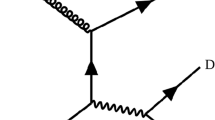Abstract
We show that the observation of the Drell–Yan production of low-mass lepton-pairs (M≲20 GeV) at high rapidities (Y≳3) at the LHC can make a direct measurement of parton distribution functions (PDFs) in the low x region, x≲10−4. We describe a procedure that greatly reduces the sensitivity of the predictions to the choice of the factorization scale and, in particular, show how, by imposing a cutoff on the transverse momentum of the lepton-pair, the data are able to probe PDFs in the important low scale, low x domain. We include the effects of the Sudakov suppression factor.





Similar content being viewed by others
Notes
Strictly speaking, z is the ratio of the light-cone momentum fraction carried by the ‘daughter’ quark to that carried by the ‘parent’ gluon, \(z=x^{+}_{q}/x^{+}_{g}\).
We take the leading ln(1/x) form of the flux so as not to distort the structure of the double \(\alpha_{s}{\rm ln}(1/x){\rm ln}M^{2}\) resummation. We find a more flexible form of the flux, with an additional z δ factor, has a negligible effect on the value found for μ 0 for a reasonable δ<0.2.
That is terms enhanced by the large value of ln(1/x).
In order to account better for the x-dependence of the incoming parton densities we may include in the flux an additional factor z δ. However, integrating over such a flux factor with δ≲0.2 gives a negligible change in the resulting value of μ 0/M for the region of interest k 0≲M/2.
It may be more collinear-safe to choose \(\mu ^{2}_{T}=M^{2}+k_{t}^{2}\). However, this is beyond the double log accuracy used in (22) and (23). Recall that the T factor is introduced to resum corrections enhanced by ln(M/k t ) for the case when k t ≪M. Therefore we prefer to simplify the formula by including the remaining corrections in the usual higher \(\mathcal{O}(\alpha _{s})\) contributions \(C_{\rm rem}^{\rm NLO,NNLO}\), see (25).
The imaginary part is cancelled between the amplitude A and its complex conjugate A ∗.
References
E.G. de Oliveira, A.D. Martin, M.G. Ryskin, Eur. Phys. J. C 72, 2069 (2012)
D. Diakonov, M.G. Ryskin, A.G. Shuvaev, J. High Energy Phys. 1302, 069 (2013)
LHCb Collaboration, CERN-LHCb-CONF-2012-013
G. Grunberg, Phys. Lett. B 95, 70 (1980)
G. Grunberg, Phys. Lett. B 110, 501 (1982)
P.M. Stevenson, Phys. Lett. B 100, 61 (1981)
P.M. Stevenson, Phys. Rev. D 23, 2916 (1981)
C. Anastasiou, L.J. Dixon, K. Melnikov, F. Petriello, Phys. Rev. D 69, 094008 (2004)
A.D. Martin, W.J. Stirling, R.S. Thorne, G. Watt, Eur. Phys. J. C 63, 189 (2009)
Y.L. Dokshitzer, D. Diakonov, S.I. Troian, Phys. Rep. 58, 269 (1980)
M.A. Kimber, A.D. Martin, M.G. Ryskin, Phys. Rev. D 63, 114027 (2001)
A.D. Martin, M.G. Ryskin, G. Watt, Eur. Phys. J. C 66, 163 (2010)
T. Coughlin, J. Forshaw, J. High Energy Phys. 1001, 121 (2010)
G. Parisi, Phys. Lett. B 90, 295 (1980)
G. Curci, M. Greco, Phys. Lett. B 92, 175 (1980)
E.M. Levin, A.D. Martin, M.G. Ryskin, T. Teubner, Z. Phys. C 74, 671 (1997)
H.-L. Lai et al. (CT10 Collaboration), Phys. Rev. D 82, 074024 (2010)
S. Alekhin, J. Blümlein, S. Moch et al. (ABM11 Collaboration), Phys. Rev. D 86, 054009 (2012)
R.D. Ball et al. (NNPDF2.3 Collaboration), Nucl. Phys. B 867, 244 (2013)
(HERA1.5 Collaboration, H1 Collaboration, ZEUS Collaboration), H1prelim-10-142, ZEUS-prel-10-018
M. Gluck, P. Jimenez-Delgado, E. Reya (GJR08 Collaboration), Eur. Phys. J. C 53, 355 (2008)
Acknowledgements
E.G.dO. and M.G.R. thank the IPPP at the University of Durham for hospitality. This work was supported by the grant RFBR 11-02-00120-a and by the Federal Program of the Russian State RSGSS-4801.2012.2; and by FAPESP (Brazil) under contract 2012/05469-4.
Author information
Authors and Affiliations
Corresponding author
Rights and permissions
About this article
Cite this article
de Oliveira, E.G., Martin, A.D. & Ryskin, M.G. Improving the Drell–Yan probe of small x partons at the LHC via a k t cut. Eur. Phys. J. C 73, 2361 (2013). https://doi.org/10.1140/epjc/s10052-013-2361-6
Received:
Revised:
Published:
DOI: https://doi.org/10.1140/epjc/s10052-013-2361-6




